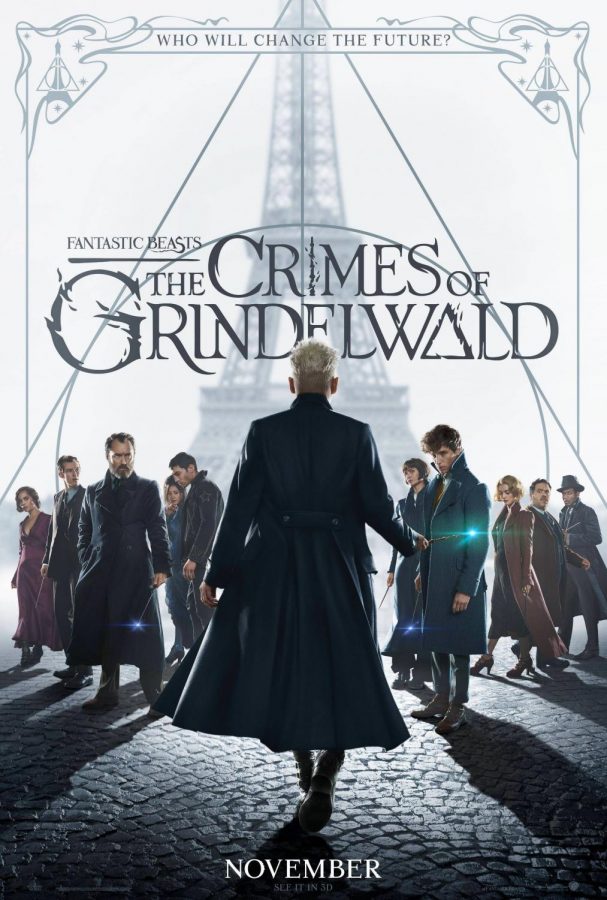Crimes of Grindelwald: Reviving the magic
The second installation of the Fantastic Beasts series continues the legacy of the Wizarding World for fans of the franchise
November 26, 2018
In 1998, the world was introduced to the Wizarding World of Harry Potter. Over the span of the next two decades, what started out as an idea on one of J.K. Rowling’s long train rides grew into a massive franchise, estimated at over $25 billion in 2016.
In 2006, I was introduced to this world. Over the next decade, my obsession with the franchise grew. I waited hours in line for every movie premiere, even if I happened to be in India over the summer. I was five years old when the seventh and final book came out. I cried for hours at the break of dawn because my cousin and older brother hadn’t woken me up to stand in line at the bookstore with them. I would fall asleep to “Hedwig’s Theme,” the signature soundtrack of the movies.
In 2011, fans like me were devastated when our adventures of the Wizarding World appeared to come to an end with the release of “Harry Potter and the Deathly Hallows: Part Two.” But in 2016, what seemed to be a revival of the franchise came about in the release of “Fantastic Beasts and Where to Find Them.”
On Nov. 16, 2018, “Fantastic Beasts: The Crimes of Grindelwald,” the second installment of the five-part Fantastic Beasts series, had the weakest opening in the franchise, raking in only $62 million domestically during its opening weekend compared to its predecessor’s $74 million debut.
After staring at the page for two days, wondering how I could possibly write a good, unbiased movie review on a franchise I could see no negative aspects to — there was simply no way. So, from the perspective of a loyal and dedicated fan of the franchise, “The Crimes of Grindelwald” offered mind-blowing plot twists and unanticipated developments that allowed fans to explore the deep history of the Wizarding World, preceding the events of the original Harry Potter series. The movie, written by J.K. Rowling, offered a captivating plot that included a sense of familiarity.
Fans of the franchise know the outcome of the plot — the search for the Deathly Hallows and the famous duel between Albus Dumbledore and Gellert Grindelwald that ends in Grindelwald’s demise is familiar to anyone who has read the series. Despite knowing the ending, for me, watching it on screen and exploring it from the perspective of Newt Scamander, a character previously known only for writing one of Harry’s school textbooks, revived the magic of the Wizarding World and renewed the excitement that comes with watching any Harry Potter movie.
The release of the trailer had me scared — while the first movie, “Fantastic Beasts and Where to Find Them,” focused on Newt’s story and didn’t seem to stir up much of the plot from the original series, the second installment seemed to be on the verge of ruining everything. From Nagini somehow being a human woman to a young version of Albus Dumbledore, the trailer made me question whether I was ready for the movie I had been so excited for. I had only known Nagini as Voldemort’s loyal snake and later, a horcrux and Dumbledore as a wise, old character with a long, flowing white beard. Would it ruin the books I had read countless times, the theme parks I dragged my parents to visit, the bedroom I had modeled after a Hogwarts dorm room, the world I had thrown myself so deeply into?
My fears were unfounded. Yes, Dumbledore, a character so loved despite his eccentricity and unreliability, seemed to become much less lovable as a young man just starting out as a teacher. Yes, I was forced to wonder if it was merely his old age and his wise eyes that made him such an endearing character. Yes, his mastery of manipulation was all too clear in the younger version of his character, played by Jude Law.
But rather than ruining an aspect of the original series for me, it allowed me to further analyze the well-loved character. And, despite these new ideas, it was easy for me to think of young Dumbledore as a separate character from the old, original one I know, just as it is easy for me to separate the Fantastic Beasts series from the original.
The connection more or less stops at the setting — other than a few familiar names and the vaguely familiar fight between good and evil, Fantastic Beasts remains fresh and completely separate. For me, the renewal of the Wizarding World was like a breath of oxygen after five years of suffocating at the prospect of the end of the magical world that had grown to be a part of my own world.
As the solemn, darker version of “Hedwig’s Theme,” unique to the Fantastic Beasts series yet reminiscent of the original series, played at the beginning of the movie, my eyes filled with tears. The few notes were a subtle reminder that I was once more about to delve into the world I loved so much.




























